Entering the final stretch of the race has a lot of nail-biting, hand-wringing, and cold-sweat-panicking going on from both sides of the aisle. Let’s stop guessing and start looking at the data coming out of the battleground states where early voting has already taken place. As we review it, keep in mind that this is early and mail voting and will likely favor Democrats as a whole, as it is expected that day-of-election voting should favor Trump and Republicans by an almost 2 to 1 margin.
Minnesota:

At 46% to 31% in favor of Dems, Minnesota has racked up a huge early vote. We know that Trump will likely win DOE voting, but not likely enough to overcome a 15 point trailing in the state. The good news is that nearly 50% of the total votes cast in 2016 remain outstanding, but that doesn’t mean that Trump wins those votes by a margin greater than 15 points to counter this. Democrats have turned out 48% of their 2016 vote, while Republicans have turned out 34% of their 2016 vote. Since those numbers are almost identical to turn out thus far, Dems will likely keep that state blue.
Iowa:
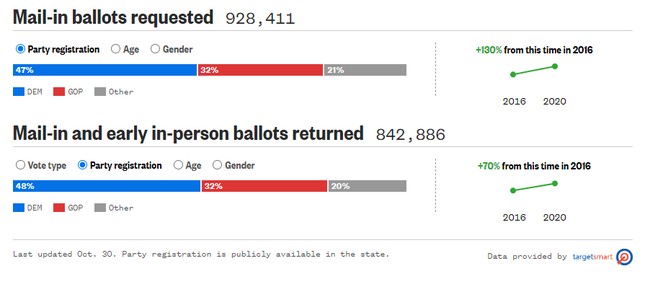
This is a disaster for Democrats. Despite a huge registration push and advantage since 2016, Dems really needed to shine in Iowa to win this state. Considering there is a 16 point advantage for Dems, over 61% of the 2016 Dem vote has already been done, while only 34% of the total Republican vote from 2016 has been cast. That means that while there’s a 16 point advantage, Dems have less than 40% remaining to turn out, while Republicans have over 65%, a 25 point advantage for Republicans. In other words, Republicans could still fail to turn out at the 2016 rate of their vote, and still win the state.
Arizona:
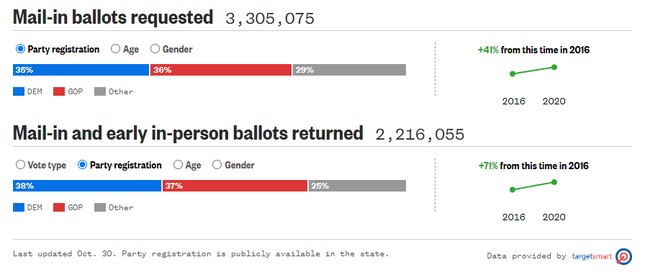
Arizona is another nightmare for Democrats. While they have a 3 point over-performance over their ballots requested number, Republicans have also out-performed their request. Trump won Arizona by 1 and a half points in 2016, and Dems only lead Republicans, in turn, out thus far by a point. Democrats have turned out 73% of their 2016 turn out, while Republicans have turned out 65% of their 2016 vote. That means that Democrats will have to find more new voters to overcome that 8 point deficit in the coming days. Sure they could draw them from independents, but I don’t think they do so at a rate high enough to cover the win. Arizona has been too close to call in the polls and now returns tell the same story. For this analysis, we will call Arizona blue.
Florida:
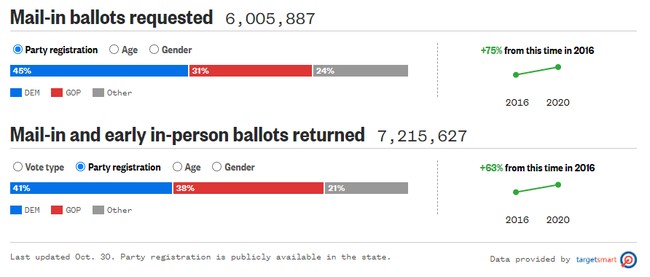
Florida’s results are a complete disaster for Democrats. Republicans are outperforming requests by 7 points, they have won the registration game since 2016, and Latin voters in the state have picked Trump at a higher rate than in 2016. Dems have turned out 66% of their 2016 turn out thus far, while Republicans have turned out, 59% of their 2016 turn out. Not only are Republicans outperforming Dems by 7 points on requests, they still have 7 points more turnout to go, with Dems only maintaining a 3 point lead. Florida stays red, and Trump wins it by a bigger margin than he did in 2016.
Georgia:
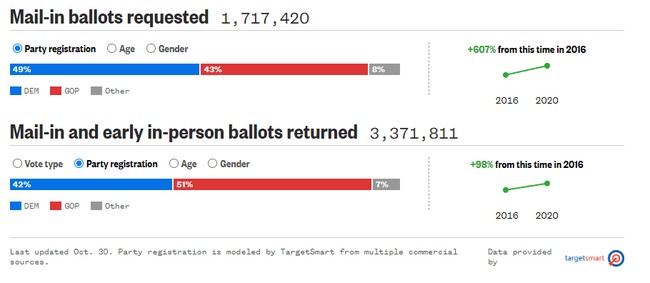
Americans have been told that Georgia is going blue this cycle. No, it isn’t. Not only have Republicans returned a majority of ballots even though Democrats requested 6% more than them, but DOE voting will also lean Republican as well. Republicans have out-performed their requests by 8 points while Democrats have under-performed their requests by 1. Democrats have turned out 75% of their 2016 turn out, while Republicans have tuned out 82% of their 2016 turn out. Democrats indeed have more votes yet to turn out, but I don’t believe it is enough to overcome a 9 point deficit. Georgia stays red. Trump doesn’t beat his 2016 showing in the state though.
Michigan:
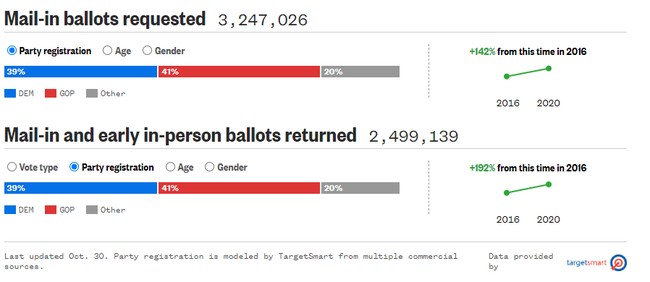
Michigan is another one of the states that should send a chill up the spine of Democrats. Trump won the state in 2016 by just 11,000 votes and Democrats have spent a lot of time and money in Michigan. Thus far, Republicans have turned out 45% of their 2016 voters, while Democrats have turned out 42% meaning that more than half the vote from 2016 is still outstanding. The problem with that for Democrats is that DOE voters will trend right. Michigan stays red.
Wisconsin:
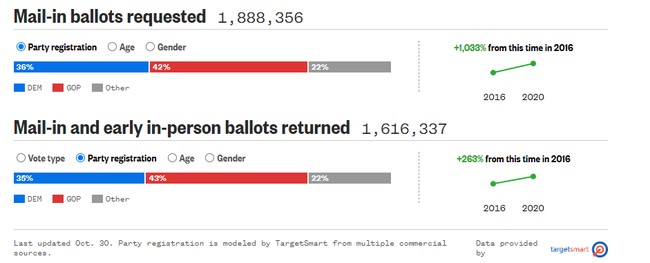
Wisconsin is another state that Democrats should have gotten back in 2020. Trump won Wisconsin by about 23,000 votes, placing the reliably blue state into the swing state category. This year looks no better for Democrat prospects. This year, Democrats have turned out about 41% of their 2016 turnout in early voting, and fall a point behind their request rate. That point is picked up by the Republicans, who have turned out 49% of their 2016 vote thus far. Again, DOE voting should fall for Trump, which places Wisconsin back into Trump’s win column in 2020.
Ohio:
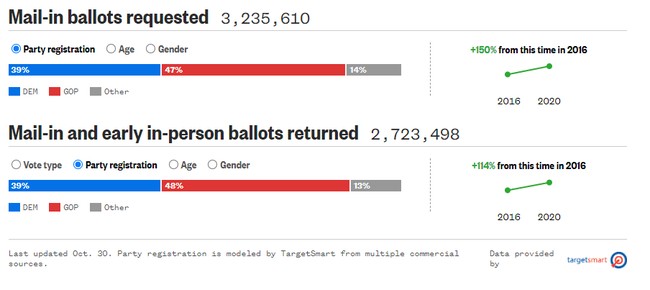
In 2016, Trump won Ohio by 8.1 points, outperforming polling for the state by nearly 6 points. It was a surprise that shocked Democrats and pollsters alike. In early voting, Democrats have turned out 44% of their 2016 turn out. Dems really had to run up the score here and you’d expect them to have over 50% of their 2016 vote in by now. On the other hand, Republicans lead Democrats in returns by 9 points, and they have 46% of their return in, which again, will likely lead to a Trump victory in Ohio with DOE voters as well. Ohio stays red.
Nevada:
Nevada went to Clinton by a slim margin in 2016. I thought that Trump was winning the state that year and was surprised to see Clinton pull off the win. This year, Nevada sent a ballot to everyone, so there’s no request statistics because, well, everyone got one anyway. In early voting, Democrats have a 4 point lead on Republicans, with Democrats turning out 70% of their 2016 vote. Republicans have turned out 67% of their vote. In 2016, the total vote for the state was 1.117 million voters. That means that 85% of the total 2016 vote has already been cast. I think Nevada will be close, but I say Biden column for now.
North Carolina:

North Carolina is another state that I am shocked to see the Democrat turn out in North Carolina as high as it is, especially considering the voter registration data that gives a 230,000 vote advantage to Republicans over their 2016 registration. That aside, Democrats have turned out 68% of their 2016 vote, while Republicans have turned out just 50% of their 2016 showing. For this simulation and consistency, I will place North Carolina into the Biden column, HOWEVER, I believe that North Carolina Republicans are showing up on Election Day with an “if you’re not first, you’re last” attitude, and Trump carries the state.
Pennsylvania:
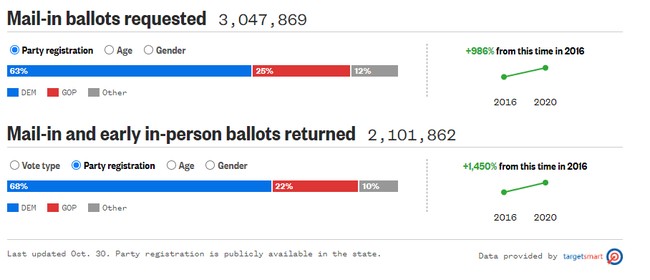
Pennsylvania went to Trump by 45,000 votes in 2016, and since then Republicans have gained 200,000 voters over Democrats. I have to say that the returns here not only are shocking but to see a 46 point advantage in early returns has to freak a lot of Republicans out too. Republicans would have to demolish Democrats in DOE voting, with a factor of at least 3 to 1. That isn’t impossible, in fact, I think it is more likely than unlikely considering that Democrats will run out of voters to turn out sooner-than-later. Democrats have turned out 49% of their 2016 vote, while Republicans have turned out just 16% of their 2016 turn out. I still believe Pennsylvania stays red in 2016, but there is a lot of catch-up Republicans have to play in the coming days. For this simulation, we will place it into the Team Biden column.
Texas:

Sorry, Dems. Texas isn’t turning blue this year. With a 16 point lead in Texas early voting for Republicans, I don’t see (and no one else should either) that Texas would flip blue, no matter how hard the media wishes it. In 2016, Trump won Texas by 9 points. In early voting, Republicans have turned out an astonishing 96% of their vote from 2016 and we haven’t even gotten to Election Day. On the other hand, Democrats have turned out 81% of their 2016 vote. I don’t see Democrats making up the difference between now and Election Day, keeping Texas red for another 4 years. Don’t be surprised if Trump beats his margin of victory in Texas this year.
What it all means:
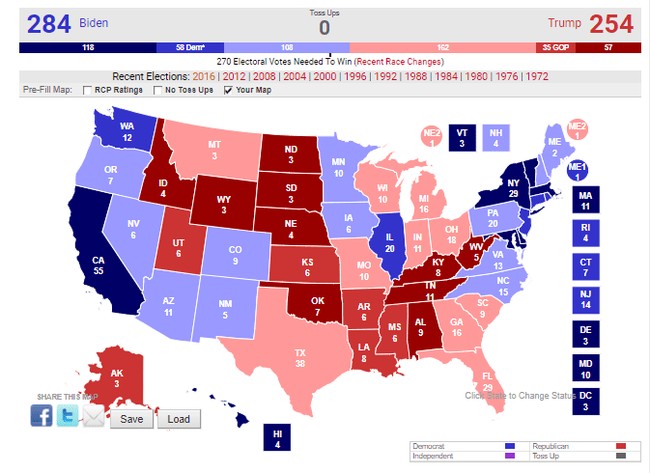
Don’t panic. This is only a simulation. The above map shows what the electoral college results would be based upon early voting. This isn’t doom and gloom. In North Carolina, a state that I think will still eventually go to Trump, Biden is doing well in early returns but I believe will eventually lose the state. The point is that even in the most optimistic of returns, Biden still only wins the Presidency by 15 Electoral votes. If we put those votes in the Trump column, we end up with a 269-269 tie, which would lead to a Trump win in the House of Representatives. Should Biden lose PA, Trump wins. Should Biden lose Iowa and Arizona, Trump wins.
Early returns are great news for Trump. Democrats began their push to election day voting just last week, but with their push for mail ballot voting before that, I don’t see where these voters are going to come from. They have maxed out their early voting in some states and others are approaching their 2016 number, despite falling registration in some states. Expect some very angry colored-haired people come Tuesday night.
Data Source: https://www.nbcnews.com/politics/2020-elections/president-results?icid=election_nav














